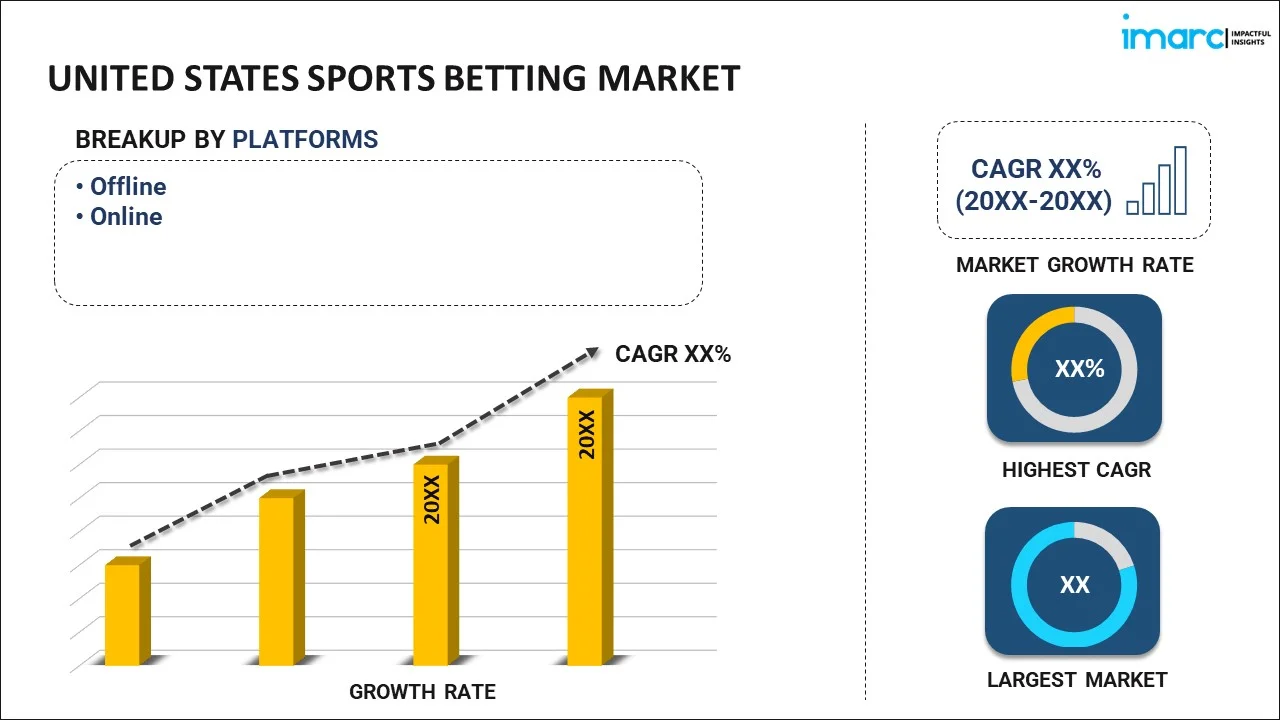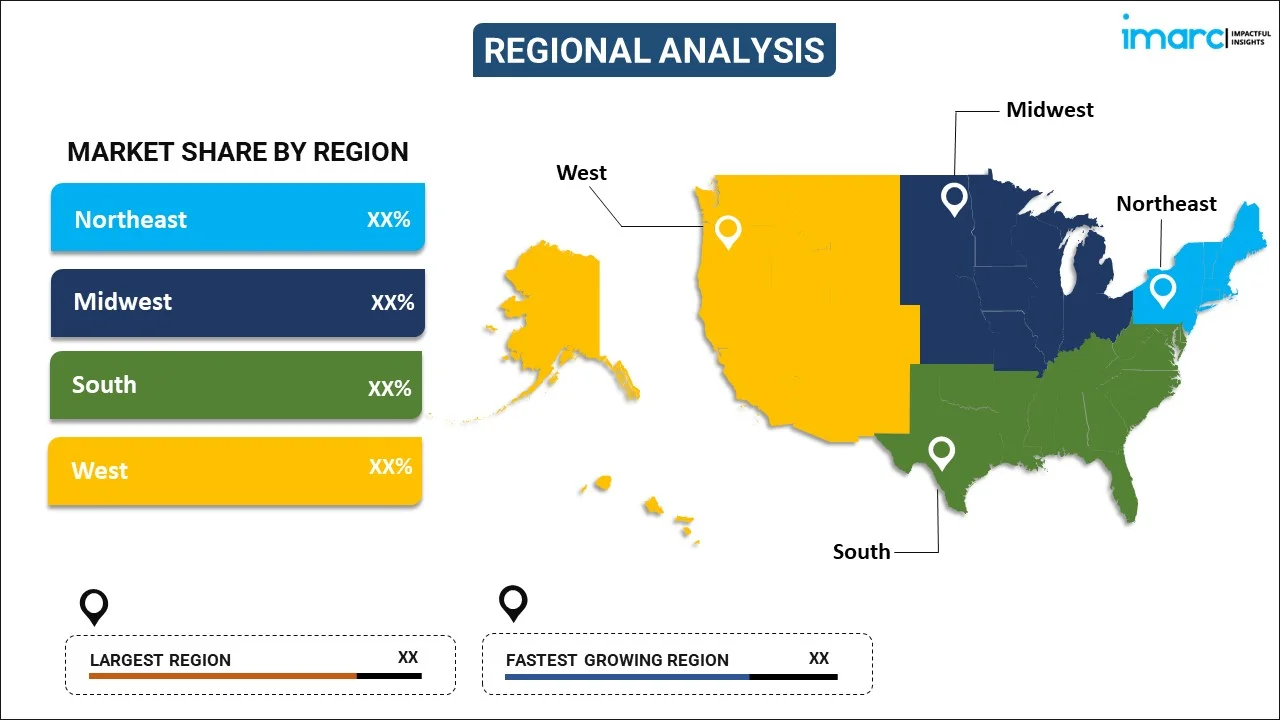
United States Sports Betting Market Report by Platform (Offline, Online), Betting Type (Fixed Odds Wagering, Exchange Betting, Live/In Play Betting, Pari-Mutuel, eSports Betting, and Others), Sports Type (Football, Basketball, Baseball, Horse Racing, Cricket, Hockey, and Others), and Region 2025-2033
United States Sports Betting Market:
The United States sports betting market size reached USD 9.6 Billion in 2024. Looking forward, IMARC Group expects the market to reach USD 27.4 Billion by 2033, exhibiting a growth rate (CAGR) of 11.10% during 2025-2033. The growing number of annual sports events and leagues is fueling the market across the country.
|
Report Attribute
|
Key Statistics
|
|---|---|
|
Base Year
|
2024
|
|
Forecast Years
|
2025-2033
|
|
Historical Years
|
2019-2024
|
|
Market Size in 2024
|
USD 9.6 Billion |
|
Market Forecast in 2033
|
USD 27.4 Billion |
| Market Growth Rate 2025-2033 | 11.10% |
United States Sports Betting Market Analysis:
- Major Market Drivers: The launch of supportive government initiatives for the legalization of activities is catalyzing the market.
- Key Market Trends: The growing partnerships with major sports leagues are enhancing awareness and engagement, which is positively influencing the market growth.
- Competitive Landscape: The report has provided a comprehensive analysis of the competitive landscape in the market. Also, detailed profiles of all major companies have been provided.
- Geographical Trends: According to market overview, South dominates the market due to its early adoption of legalized betting, favorable regulatory frameworks, and strong sports culture. Apart from this, states in the region have quickly embraced mobile platforms, thereby leading to higher participation and revenue growth.
- Challenges and Opportunities: The inconsistent state-level regulations create barriers for nationwide platforms, which hinders the market growth. However, establishing more uniform laws or federal guidelines enables consistent user experiences across states, which will continue to strengthen the market over the forecast period.
United States Sports Betting Market Trends:
Expanding Legalization Across Multiple U.S. States
The legalization of sports betting continues to expand across numerous U.S. states, facilitating the industry's substantial growth. As more states enact legislation, access to sports betting is becoming available to a broader population, thereby resulting in increased revenue streams and encouraging further investments in the industry. For instance, in July 2024, DraftKings Inc. announced the launch of its online sportsbook in Washington, D.C., pending licensure and regulatory approvals.
Increasing Mobile and Online Betting Accessibility
Mobile and online platforms are making sports betting more convenient for users, driving widespread participation. The accessibility of these platforms allows for real-time engagement, expanding user bases, and improving the overall betting experience, especially as more states legalize these options. This is contributing to the rising U.S. sports betting market value. For instance, in July 2024, BetMGM introduced its mobile sports betting app across Washington, D.C., expanding access beyond its previous Nationals Park radius. This move aims to enhance user experiences and community investment, contributing to local job creation and tax revenue in the region.
Growing Partnerships with Major Sports Platforms
Collaborations between betting operators and sports organizations are enhancing brand visibility and credibility. These partnerships are attracting more users by integrating betting services with sports content, allowing for seamless interactions and engaging a broader audience across multiple regions. For instance, in March 2024, ESPN BET launched its mobile and web sports betting platform in North Carolina, offering fans a variety of betting options. This marks the first new state launch under ESPN's partnership with PENN Entertainment, expanding legal sports betting in the state.
United States Sports Betting Industry Segmentation:
IMARC Group provides an analysis of the key trends in each segment of the market, along with the United States sports betting market forecast at the country and regional levels for 2025-2033. Our report has categorized the market based on the platform, betting type, and sports type.
Breakup by Platform:

- Offline
- Online
Offline segment holds the largest market share
The report has provided a detailed breakup and analysis of the market based on the platform. This includes offline and online. According to the report, offline represented the largest market segmentation.
The offline segment dominates the United States sports betting market, with casinos like MGM Resorts offering in-person betting experiences. Retail sportsbooks continue to attract bettors, providing a traditional setting for wagering alongside online options, significantly impacting the sports betting U.S. market share.
Breakup by Betting Type:
- Fixed Odds Wagering
- Exchange Betting
- Live/In Play Betting
- Pari-Mutuel
- eSports Betting
- Others
Live/in play betting exhibits a clear dominance in the market
The report has provided a detailed breakup and analysis of the market based on the betting type. This includes fixed odds wagering, exchange betting, live/in play betting, pari-mutuel, e-sports betting, and others. According to the report, live/in play betting represented the largest market segmentation.
The live/in-play betting segment dominates the United States sports betting market share, allowing real-time wagers during events. For instance, DraftKings' platform enhances user engagement by offering dynamic, in-game betting options across various sports.
Breakup by Sports Type:
- Football
- Basketball
- Baseball
- Horse Racing
- Cricket
- Hockey
- Others
Football exhibits a clear dominance in the market
The report has provided a detailed breakup and analysis of the market based on the sports type. This includes football, basketball, baseball, horse racing, cricket, hockey, and others. According to the report, football represented the largest market segmentation.
The football segment dominates the United States sports betting market, driven by the popularity of NFL and college football. For example, DraftKings reported significant wagers during the NFL season, boosting overall market engagement. Besides this, the expanding sports industry is also stimulating the market.
Breakup by Region:

- Northeast
- Midwest
- South
- West
South currently dominates the United States sports betting market
The report has also provided a comprehensive analysis of all the major regional markets, which include the Northeast, Midwest, South, and West. According to the report, the South represented the largest segment.
According to the United States Sports betting market trends, the South currently dominates the market due to its widespread adoption of legal betting and strong sports culture. For example, Louisiana has seen rapid growth in mobile sports betting after its launch, generating substantial revenue and attracting new users. The region's passion for sports, particularly football, combined with favorable regulations, has fueled this dominance. As more southern states embrace online platforms and partnerships with major sports operators, the region continues to lead in terms of market expansion, revenue generation, and user engagement across the country.
Competitive Landscape:
The market research report has also provided a comprehensive analysis of the competitive landscape in the market. Competitive market price analysis, such as market structure, key player positioning, top winning strategies, competitive dashboard, and company evaluation quadrant, has been covered in the report. Also, detailed profiles of all major companies have been provided.
United States Sports Betting Market Recent Developments:
- July 2024: BetMGM introduced its mobile sports betting app across Washington, D.C., expanding access beyond its previous Nationals Park radius. This move aims to enhance user experiences and community investment, contributing to local job creation and tax revenue in the region.
- July 2024: DraftKings Inc. announced the launch of its online sportsbook in Washington, D.C., pending licensure and regulatory approvals.
- March 2024: ESPN BET launched its mobile and web sports betting platform in North Carolina, offering fans a variety of betting options. This marks the first new state launch under ESPN's partnership with PENN Entertainment, expanding legal sports betting in the state.
United States Sports Betting Market Report Scope:
| Report Features | Details |
|---|---|
| Base Year of the Analysis | 2024 |
| Historical Period | 2019-2024 |
| Forecast Period | 2025-2033 |
| Units | Billion USD |
| Segment Coverage | Exploration of Historical Trends and Market Outlook, Industry Catalysts and Challenges, Segment-Wise Historical and Predictive Market Assessment:
|
| Platforms Covered | Offline, Online |
| Betting Types Covered | Fixed Odds Wagering, Exchange Betting, Live/In Play Betting, Pari-Mutuel, eSports Betting, Others |
| Sports Types Covered | Football, Basketball, Baseball, Horse Racing, Cricket, Hockey, Others |
| Regions Covered | Northeast, Midwest, South, West |
| Customization Scope | 10% Free Customization |
| Post-Sale Analyst Support | 10-12 Weeks |
| Delivery Format | PDF and Excel through Email (We can also provide the editable version of the report in PPT/Word format on special request) |
Key Benefits for Stakeholders:
- IMARC’s industry report offers a comprehensive quantitative analysis of various market segments, historical and current market trends, market forecasts, and dynamics of the United States sports betting market from 2019-2033.
- The research report provides the latest information on the market drivers, challenges, and opportunities in the United States sports betting market.
- Porter's five forces analysis assists stakeholders in assessing the impact of new entrants, competitive rivalry, supplier power, buyer power, and the threat of substitution. It helps stakeholders to analyze the level of competition within the United States sports betting industry and its attractiveness.
- The competitive landscape allows stakeholders to understand their competitive environment and provides insight into the current positions of key players in the market.
Key Questions Answered in This Report
We expect the United States sports betting market to exhibit a CAGR of 11.10% during 2025-2033.
The increasing number of annual sports events and leagues across the US, along with the growing integration of blockchain technology with sports betting apps for automating real-time data, is primarily driving the United States sports betting market.
The sudden outbreak of the COVID-19 pandemic has led to the rising adoption of online betting and increasing utilization of various virtual currencies, such as Ripple, Bitcoin, Dogecoin, etc., for administering transactions, owing to the temporary closure of numerous retail sports-betting across the nation.
Based on the platform, the United States sports betting market can be categorized into offline and online, where offline holds the largest market share.
Based on the betting type, the United States sports betting market has been segregated into fixed odds wagering, exchange betting, live/in play betting, pari-mutuel, eSports betting, and others. Among these, live/in play betting currently accounts for the majority of the total market share.
Based on the sports type, the United States sports betting market can be bifurcated into football, basketball, baseball, horse racing, cricket, hockey, and others. Currently, football exhibits a clear dominance in the market.
On a regional level, the market has been classified into Northeast, Midwest, South, and West, where South currently dominates the United States sports betting market.
Need more help?
- Speak to our experienced analysts for insights on the current market scenarios.
- Include additional segments and countries to customize the report as per your requirement.
- Gain an unparalleled competitive advantage in your domain by understanding how to utilize the report and positively impacting your operations and revenue.
- For further assistance, please connect with our analysts.
 Inquire Before Buying
Inquire Before Buying
 Speak to an Analyst
Speak to an Analyst
 Request Brochure
Request Brochure
 Request Customization
Request Customization




.webp)




.webp)












